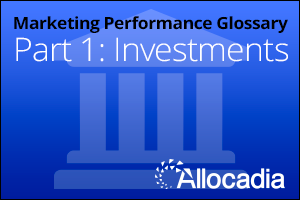 It’s important for marketers in the same organization to have a shared understanding of commonly-used marketing performance terms. This common language serves as the foundation of our Path to Performance.
It’s important for marketers in the same organization to have a shared understanding of commonly-used marketing performance terms. This common language serves as the foundation of our Path to Performance.
To help your team communicate more effectively, I’m sharing basic definitions in a Marketing Performance glossary. Today, let’s look at marketing investments.
4 Key Marketing Investments Terms
To understand marketing investments, you need to know four key terms:
1. Investment Target
Note: “Budget” can be an imprecise term with more than one meaning. “Target” is a more specific alternative, because it refers to the fact that companies aim to invest a particular amount, not over- or under-spending.
The Investment Target is a top-down number that’s usually set by the CMO that represents the organization’s strategic priorities.
There are two types of Investment Target:
Functional: “Sending the money to where the people are”. This is the traditional, practical way of allocating top-down budget dollars. Money is typically distributed by Region, Team or Cost Center.
Strategic: “Placing the money towards objectives”. This is a newer method of target allocation, often recommended by analyst groups. With strategic investment targets, organizations are funding their go-to-market strategies.
For many businesses, investment targets end up being a matrix of both of the above: the targets are most often set by the CMO, but allocated by Finance.
2. Investment Plan
Investment Plans are a bottoms-up numbers which marketers across the organization put together in order to meet the investment target.
While it’s most common for Investment plans to be built by functional grouping (for example, public relations, events, etc.), systems like Allocadia allow Investment Plans to be grouped however marketers choose: according to vendor, objective, or whatever makes most sense on a daily basis. Then, these plan numbers can be tagged according to (audience, objective) so they can be rolled-up to provide strategic views.
After each team’s plan has been created, marketing leaders can step back to ask questions such as:
- Which teams haven’t entered their activities?
- Which teams aren’t planning spend in the right areas?
- Are we appropriately allocating spend by region and category?
- Is the plan aligned with the overall strategic direction that we used to inform the Investment Target
3. Investment Commits
The Investment Commit is money that has been earmarked for spending within the finance system. With the commit numbers, marketers are communicating to the finance team: “please reserve these dollars, because we are going to spend them”.
Some organizations define “commit” as funds that have been verbally agreed to or that represent signed contracts, but a purchase order (P.O.) is the most common definition of the Investment Commit.
4. Investment Actuals
The Investment Actual is the precise amount of money actually spent on a good or service, as recorded in your finance or ERP system. Accrual accounting plays an important role here! Check out our recent post on this topic: Accrual World: What is Accrual Accounting and Why Does It Matter to Marketers
5. Investment Forecast
The fourth piece of the puzzle, Investment Forecast, isn’t input from a specific person or team. Instead, the forecast is a calculated figure that merges past actuals and future plan to give marketing leaders a true forecast of what they’re on track to spend in coming weeks and months.
Stay tuned for more Marketing Performance Management glossary entries, where we’ll define important Results and ROI terminology. All these terms and more are also covered in our Path to Performance eBook.
This article was syndicated from Business 2 Community: Marketing Performance Glossary: Investments
More Business & Finance articles from Business 2 Community:




